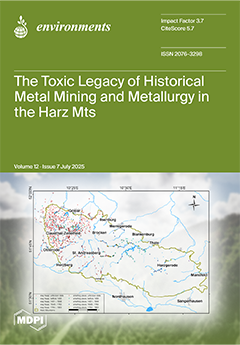The use of chloride-based deicing salts, particularly sodium chloride (NaCl) and calcium chloride (CaCl
2), is a common practice in cold regions for maintaining road safety during winter. However, the accumulation of salt residues in adjacent soils poses serious environmental threats, including
[...] Read more.
The use of chloride-based deicing salts, particularly sodium chloride (NaCl) and calcium chloride (CaCl
2), is a common practice in cold regions for maintaining road safety during winter. However, the accumulation of salt residues in adjacent soils poses serious environmental threats, including reduced pH, increased electrical conductivity (EC), disrupted soil structure, and plant growth inhibition. This study aimed to evaluate the combined effect of activated carbon (AC) and
Pennisetum alopecuroides, a salt-tolerant perennial grass, in alleviating salinity stress under deicer-treated soils. A factorial greenhouse experiment was conducted using three fixed factors: (i) presence or absence of
Pennisetum alopecuroides, (ii) deicer type (NaCl or CaCl
2), and (iii) activated carbon mixing ratio (0, 1, 2, 5, and 10%). Soil pH, EC, and ion concentrations (Na
+, Cl
−, Ca
2+) were measured, along with six plant growth indicators. The results showed that increasing AC concentrations significantly increased pH and reduced EC and ion accumulation, with the 5% AC treatment being optimal in both deicer systems. Plant physiological responses were improved in AC-amended soils, especially under CaCl
2 treatment, indicating less ion toxicity and better root zone conditions. The interaction effects between AC, deicer type, and plant presence were statistically significant (
p < 0.05), supporting a synergistic remediation mechanism involving both adsorption and biological uptake. Despite the limitations of short-term controlled conditions, this study offers a promising phytomanagement strategy using natural adsorbents and salt-tolerant plants for sustainable remediation of salt-affected soils in road-adjacent and urban environments.
Full article





